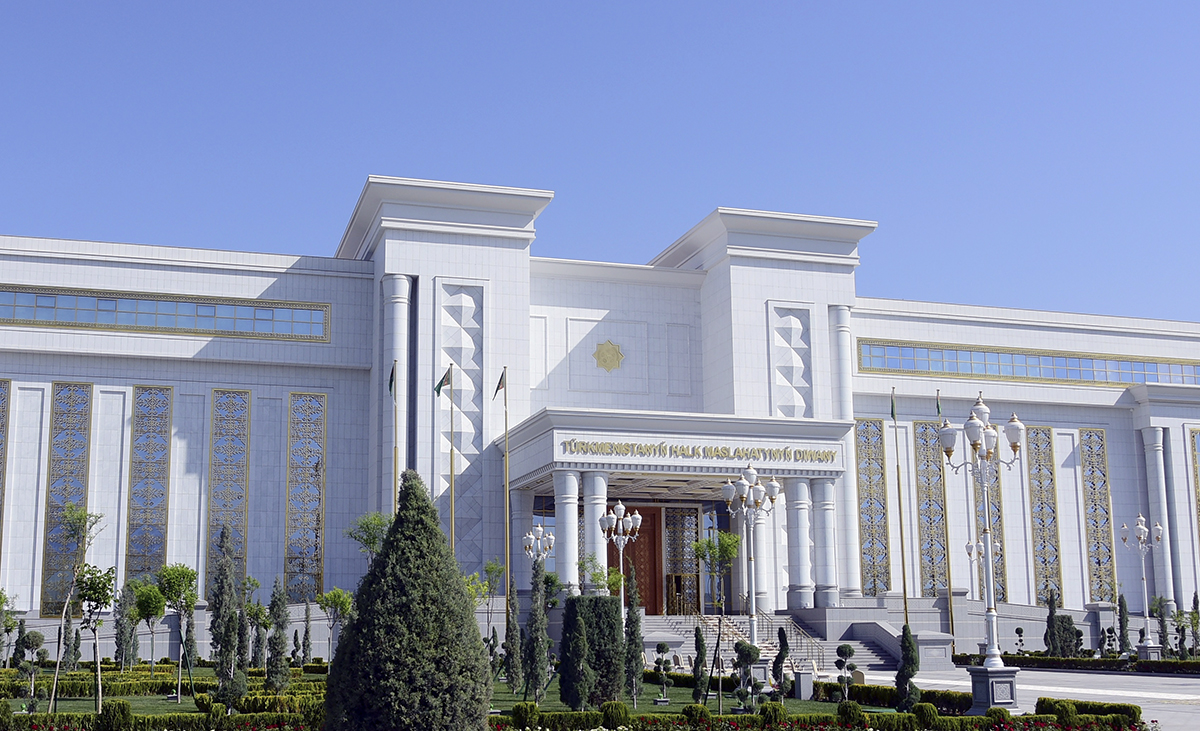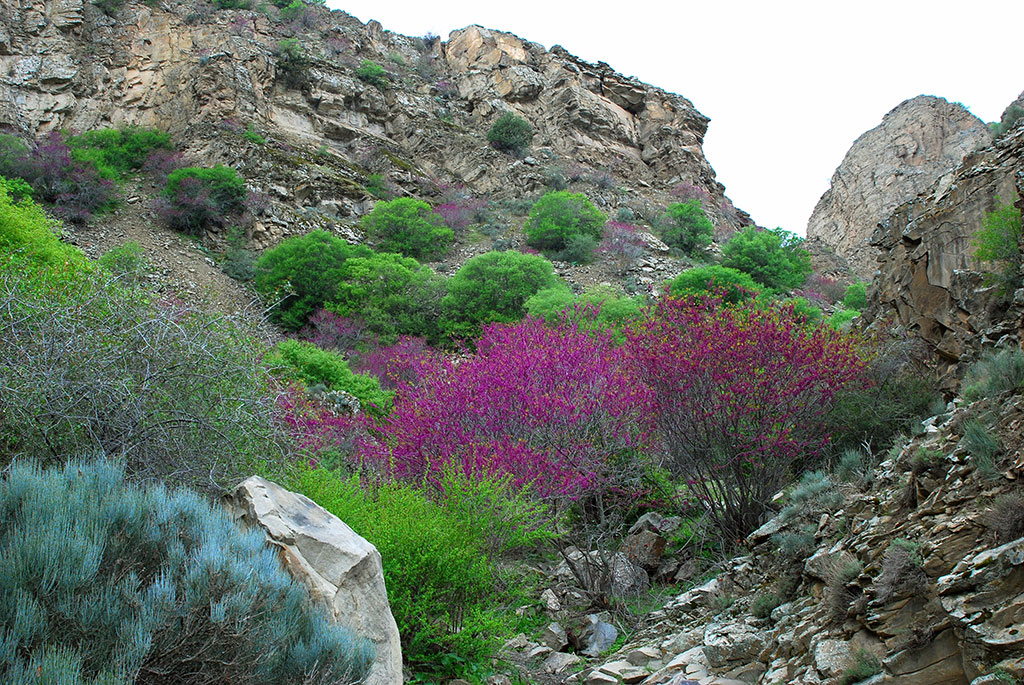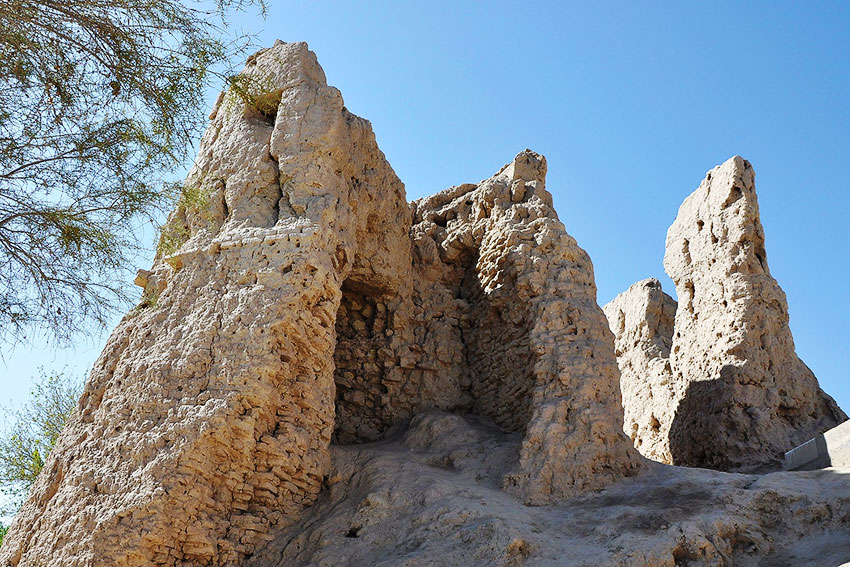The great civilization of the Murgab oasis had a crucial influence on not only the destiny of the Turkmen nation but also that of the peoples of the East. Mary was the largest urban core like such megalopolises as Babylon and Athens, Mohenjo-daro and Tenochtitlan. But these cities existed as the centres of civilization of only one epoch; Mary had shined for two epochs – in antiquity and the Middle Ages

The lands of the magnificent Murghab oasis were recognized as the fifth centre of the world. Its ancient capital was the ancient settlement of Gonur-depe that took its name after the mound Gonur - the centre of the largest country that existed during the Bronze Age.
The Murghab River has changed its course several times over many centuries, and people had to leave their old settlements and build new cities on the banks of the river.

The city the monuments of which are situated not far from Bayramali was founded in the 7th century BC. Historians call this city Ancient Merv as opposed to the cities known as the country of Margush that existed during the Bronze Age.
In different epochs different people called Mary in their own way using a great variety of epithets. Mary was first mentioned as Mouru in the Zoroastrian sacred text – Avesta (2nd millennium BC). The cuneiform texts found on the Behistun rock (4th century BC) called the antique city Margush. In the Hellenic texts the ancient city is referred to as Margiana, and in the medieval oriental authors poetically called the city Maru ash-Shahijan that means Mary - the soul of kings or Maru Shahujahan (Mary - the seat of the king of the world) and Medinat Khorasan (The capital of Khorasan) in the period of its astounding growth and prosperity. In different sources Mary was compared to the beautiful Garden of Eden, the city that the world is built on and referred to as the mother of the cities of Khorasan.

Ancient Merv is a group of the sites of ancient settlements (Erk-kala, Gyaur-kala, Soltan-kala, Abdullakhan-kala, Bayramalikhan-kala) that were founded and abandoned, and people settled down in neighbouring territories.
In the early 5th century BC Mary was a part of the Achaemenids Empire, and in the 4th century BC it was a part of the empire of Alexander of Macedon. It collapsed soon and Mary was included into the Seleucid Empire. During the reign of Antiochus Soter (280-261 BC) the wall that was 230 km long was built around the city. The construction like this had no analogues during that epoch. In the 3rd century BC-the 3rd century AD, Mary was a part of the Parthian Empire. In the Middle Ages, during the reign of the Caliph al-Mamun the city played the role of the capital of the Arab caliphate, but it flourished during the epoch of the Great Turkmen-Seljuk Empire, especially when Sultan Sanjar made Mary the capital of the state. The medieval architectural monuments such as Big and Small Kyz Kala (6th century), the mausoleums of Muhammed ibn Zeyid (12th century), Hudaynazar-ovliya (12th century), Kyz-bibi (11th century), the askhabs’ tombs (12th century), the Khoja Yusuf Hamadani Mosque (16th century) and others add special colours to Ancient Merv.

However, the pearl of the East is certainly the Sultan Sanjar Mausoleum – a masterpiece of the Northern Khorasan school of architecture. The system of brick vaulting of the double covering (an architect from Serhas Muhammed ibn Atsyz) was replicated three centuries later in the Santa Maria del Fiore in Florence by Filippo Brunelleschi, one of the foremost architects and engineers of the Italian Renaissance.
Mary was the largest centre of science, arts, crafts and trade. Mary situated at the routes of the Great Silk Road was the homeland to Zoroastrianism and a shelter for the adherents to Manichaeism, Buddhism, Judaism and Christianity. In the 5th century the city was a major centre for Nestorian Christianity (the church Haroba-kyoshk was found in Mary) and the Buddhists from all over Central Asia resided there. It was the Buddhists in Merv who made translation of the major texts from the Sanskrit to Chinese, and manuscripts in the Brahmi script and the Sanskrit found in the Buddhist temple in Merv in 1965 are the oldest known samples ever discovered in the world.

Many scholars lived in medieval Mary in the Middle Ages. It was the homeland for the unique schools of healers (Ibn Mas, Sahl Rabban), mathematicians and astronomers (for example, Habash-mathematician who was the first scholar in the world to use the trigonometric functions of tangent and cotangent), philosophers, geographers, physicists (for example, al-Khazini invented the hydrometer and was the first scholar in the world to study the physical properties of air), historians (for example, Abu Sada al-Samani who wrote more than 20 works on the history of Mary), etc.
The school of poets known as Mervezi was formed in the city. There were ten largest book depositories in Merv before the Mongol invasion. An Arab geographer and biography writer Yakut Rumi (1179- 1229) wrote, “I have never seen anything in the world that can be compared with them by quality and superiority.”
Ancient Merv was a major industrial centre. Steel weapons and armour, fine pottery, glass, pieces of jewellery were made there. Sculptors, architects, painters in metal, wood and stone worked there. Fine silk, wool and cotton fabrics produced in Merv were exported to countries of East and West. Baghdad caliphs dressed in silk mulham and cazin made in Merv.

The highly developed irrigation system used in Ancient Merv was under the control of the state. Over ten thousands of people (!), of them 400 divers, were engaged in maintaining the system. This irrigation system impressed the Arabs so greatly that they called a canal Merv in Baghdad in the 18th century.
When talking about Ancient Merv, palaces and mosques, temples and castles, madrasahs and libraries, fortresses and mausoleums appear before our eyes like in reality. It is the unique and magnificent civilization founded by the ancestors of the Turkmen people rising from the ashes.

The lands of the magnificent Murghab oasis were recognized as the fifth centre of the world. Its ancient capital was the ancient settlement of Gonur-depe that took its name after the mound Gonur - the centre of the largest country that existed during the Bronze Age.
The Murghab River has changed its course several times over many centuries, and people had to leave their old settlements and build new cities on the banks of the river.

The city the monuments of which are situated not far from Bayramali was founded in the 7th century BC. Historians call this city Ancient Merv as opposed to the cities known as the country of Margush that existed during the Bronze Age.
In different epochs different people called Mary in their own way using a great variety of epithets. Mary was first mentioned as Mouru in the Zoroastrian sacred text – Avesta (2nd millennium BC). The cuneiform texts found on the Behistun rock (4th century BC) called the antique city Margush. In the Hellenic texts the ancient city is referred to as Margiana, and in the medieval oriental authors poetically called the city Maru ash-Shahijan that means Mary - the soul of kings or Maru Shahujahan (Mary - the seat of the king of the world) and Medinat Khorasan (The capital of Khorasan) in the period of its astounding growth and prosperity. In different sources Mary was compared to the beautiful Garden of Eden, the city that the world is built on and referred to as the mother of the cities of Khorasan.

Ancient Merv is a group of the sites of ancient settlements (Erk-kala, Gyaur-kala, Soltan-kala, Abdullakhan-kala, Bayramalikhan-kala) that were founded and abandoned, and people settled down in neighbouring territories.
In the early 5th century BC Mary was a part of the Achaemenids Empire, and in the 4th century BC it was a part of the empire of Alexander of Macedon. It collapsed soon and Mary was included into the Seleucid Empire. During the reign of Antiochus Soter (280-261 BC) the wall that was 230 km long was built around the city. The construction like this had no analogues during that epoch. In the 3rd century BC-the 3rd century AD, Mary was a part of the Parthian Empire. In the Middle Ages, during the reign of the Caliph al-Mamun the city played the role of the capital of the Arab caliphate, but it flourished during the epoch of the Great Turkmen-Seljuk Empire, especially when Sultan Sanjar made Mary the capital of the state. The medieval architectural monuments such as Big and Small Kyz Kala (6th century), the mausoleums of Muhammed ibn Zeyid (12th century), Hudaynazar-ovliya (12th century), Kyz-bibi (11th century), the askhabs’ tombs (12th century), the Khoja Yusuf Hamadani Mosque (16th century) and others add special colours to Ancient Merv.

However, the pearl of the East is certainly the Sultan Sanjar Mausoleum – a masterpiece of the Northern Khorasan school of architecture. The system of brick vaulting of the double covering (an architect from Serhas Muhammed ibn Atsyz) was replicated three centuries later in the Santa Maria del Fiore in Florence by Filippo Brunelleschi, one of the foremost architects and engineers of the Italian Renaissance.
Mary was the largest centre of science, arts, crafts and trade. Mary situated at the routes of the Great Silk Road was the homeland to Zoroastrianism and a shelter for the adherents to Manichaeism, Buddhism, Judaism and Christianity. In the 5th century the city was a major centre for Nestorian Christianity (the church Haroba-kyoshk was found in Mary) and the Buddhists from all over Central Asia resided there. It was the Buddhists in Merv who made translation of the major texts from the Sanskrit to Chinese, and manuscripts in the Brahmi script and the Sanskrit found in the Buddhist temple in Merv in 1965 are the oldest known samples ever discovered in the world.

Many scholars lived in medieval Mary in the Middle Ages. It was the homeland for the unique schools of healers (Ibn Mas, Sahl Rabban), mathematicians and astronomers (for example, Habash-mathematician who was the first scholar in the world to use the trigonometric functions of tangent and cotangent), philosophers, geographers, physicists (for example, al-Khazini invented the hydrometer and was the first scholar in the world to study the physical properties of air), historians (for example, Abu Sada al-Samani who wrote more than 20 works on the history of Mary), etc.
The school of poets known as Mervezi was formed in the city. There were ten largest book depositories in Merv before the Mongol invasion. An Arab geographer and biography writer Yakut Rumi (1179- 1229) wrote, “I have never seen anything in the world that can be compared with them by quality and superiority.”
Ancient Merv was a major industrial centre. Steel weapons and armour, fine pottery, glass, pieces of jewellery were made there. Sculptors, architects, painters in metal, wood and stone worked there. Fine silk, wool and cotton fabrics produced in Merv were exported to countries of East and West. Baghdad caliphs dressed in silk mulham and cazin made in Merv.

The highly developed irrigation system used in Ancient Merv was under the control of the state. Over ten thousands of people (!), of them 400 divers, were engaged in maintaining the system. This irrigation system impressed the Arabs so greatly that they called a canal Merv in Baghdad in the 18th century.
When talking about Ancient Merv, palaces and mosques, temples and castles, madrasahs and libraries, fortresses and mausoleums appear before our eyes like in reality. It is the unique and magnificent civilization founded by the ancestors of the Turkmen people rising from the ashes.






